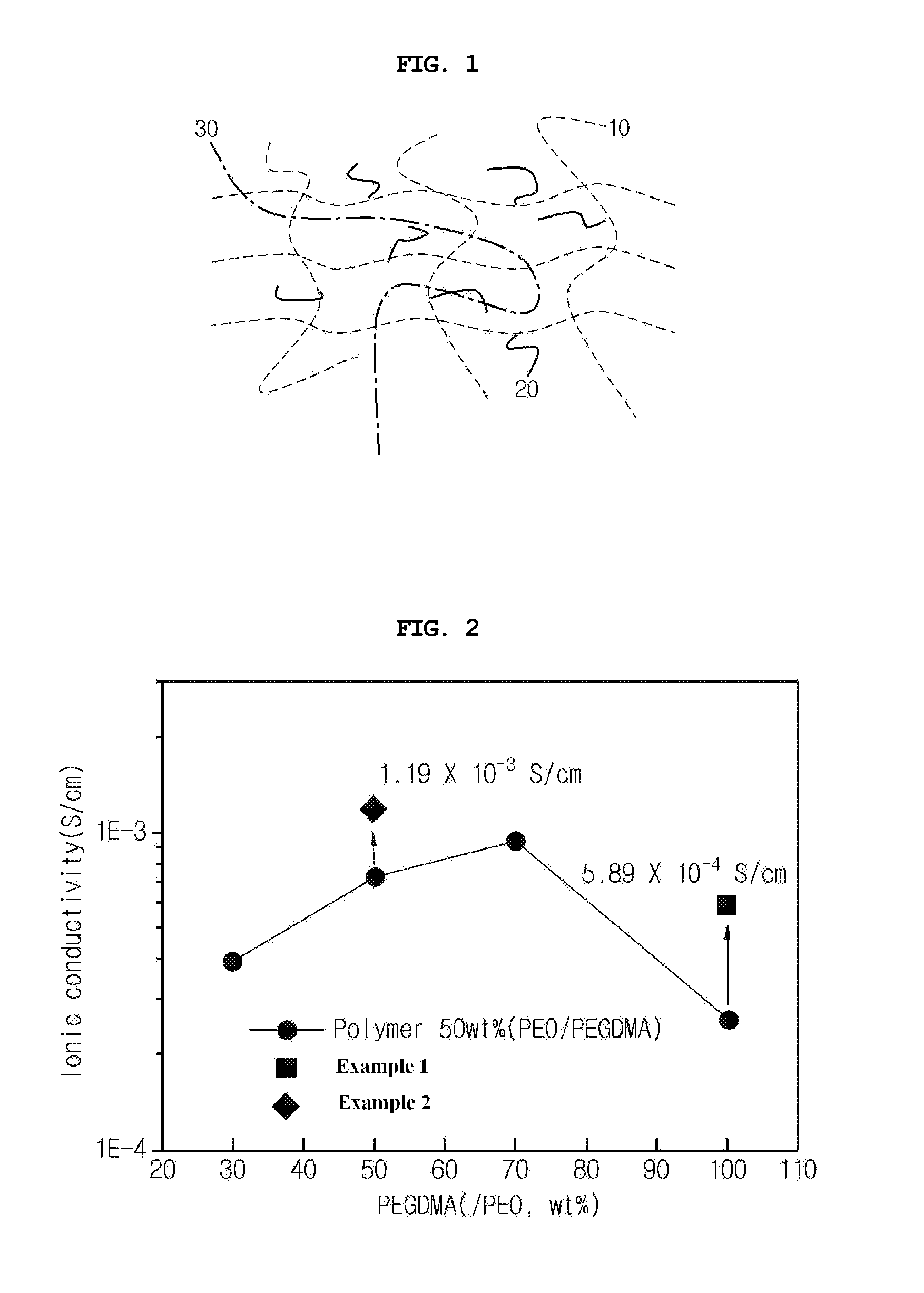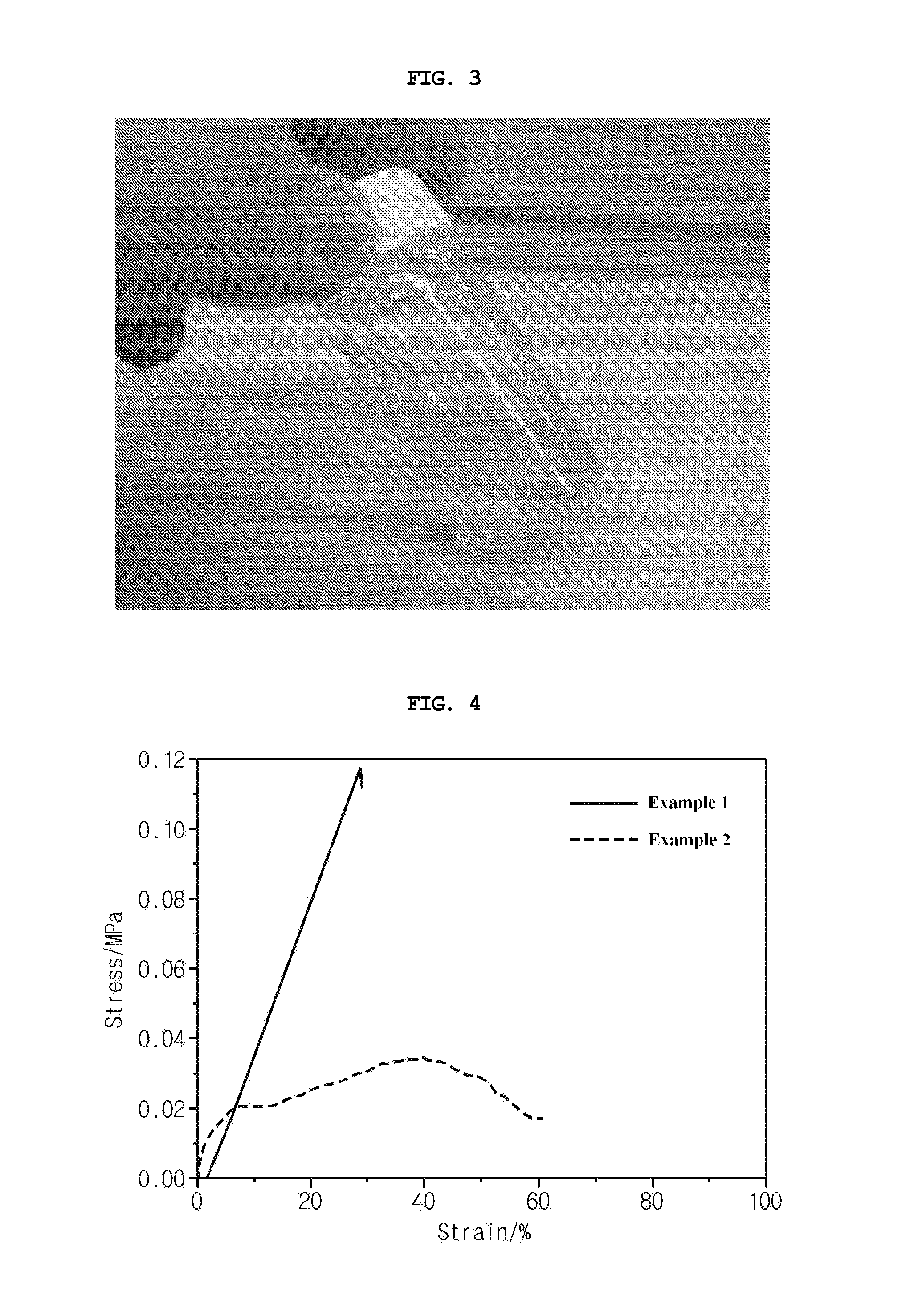Electrolyte for electrochemical device, method for preparing the same and electrochemical device including the same
a technology of electrochemical devices and electrolyte, which is applied in the field of electrochemical devices including electrolyte, can solve the problems of increasing the possibility of evaporation of organic solvents, increasing the temperature of batteries, and increasing the demand for secondary batteries, etc., and achieves high mechanical strength, high ionic conductivity, and easy change
- Summary
- Abstract
- Description
- Claims
- Application Information
AI Technical Summary
Benefits of technology
Problems solved by technology
Method used
Image
Examples
example 1
Preparation of PCE / PEGDMA / PEGMA Solid Electrolyte
[0053]50 parts by weight of succinonitrile as a plastic crystal electrolyte (PCE), 25 parts by weight of polyethylene glycol dimethacrylate (PEGDMA) having a weight average molecular weight of 400, and 25 parts by weight of polyethylene glycol methacrylate (PEGMA) having a weight average molecular weight of 400 were mixed. To the mixture was added lithium bis(trifluoromethanesulfonyl)imide in such an amount that the molar ratio of the lithium salt to the ethylene oxide units of the PEGDMA and PEGMA was 1:8. After the mixture was homogenized, benzoin as a UV initiator was added thereto in an amount of 3 wt %, based on the total weight of the PEGDMA and PEGMA.
[0054]Thereafter, the resulting mixture was cast on a glass plate and irradiated with UV light for 1 min. As a result of the polymerization, an electrolyte was produced in the form of a membrane.
example 2
Preparation of PCE / PEO / PEGDMA / PEGMA Solid Electrolyte
[0055]50 parts by weight of succinonitrile, 25 parts by weight of polyethylene oxide, 12.5 parts by weight of polyethylene glycol dimethacrylate (PEGDMA) having a weight average molecular weight of 400, and 12.5 parts by weight of polyethylene glycol methacrylate (PEGMA) having a weight average molecular weight of 400 were mixed. To the mixture was added lithium bis(trifluoromethanesulfonyl)imide in such an amount that the molar ratio of the lithium salt to the ethylene oxide units of the PEO, PEGDMA and PEGMA was 1:8. After the mixture was homogenized, benzoin as a UV initiator was added thereto in an amount of 3 wt %, based on the total weight of the PEGDMA and PEGMA.
[0056]Thereafter, the resulting mixture was cast on a glass plate and irradiated with UV light for 1 min. As a result of the polymerization, an electrolyte was produced in the form of a membrane.
PUM
| Property | Measurement | Unit |
|---|---|---|
| weight | aaaaa | aaaaa |
| structure | aaaaa | aaaaa |
| electrical energy | aaaaa | aaaaa |
Abstract
Description
Claims
Application Information
 Login to View More
Login to View More - R&D
- Intellectual Property
- Life Sciences
- Materials
- Tech Scout
- Unparalleled Data Quality
- Higher Quality Content
- 60% Fewer Hallucinations
Browse by: Latest US Patents, China's latest patents, Technical Efficacy Thesaurus, Application Domain, Technology Topic, Popular Technical Reports.
© 2025 PatSnap. All rights reserved.Legal|Privacy policy|Modern Slavery Act Transparency Statement|Sitemap|About US| Contact US: help@patsnap.com


